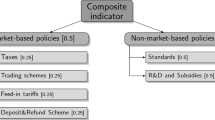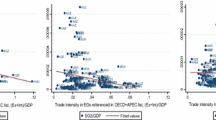Abstract
Some scholars argue that trade liberalization results in the ‘outsourcing’ of pollution to pollution havens, and this may explain the existence of the environmental Kuznets curve (EKC) in industrialized countries. Others claim that trade liberalization effectively lessens pollution by allowing a more efficient use of resources and the diffusion of clean technologies. In part because these theories generate similar predictions for industrialized countries, empirical studies have not provided conclusive evidence for either argument. To identify the role of trade, I draw on the insights of the diffusion literature and estimate a spatial regression model where trade operates as the mechanism through which pollution shifts from country to country. Using the case of per-capita carbon dioxide \((\hbox {CO}_2)\) emissions, I find that once spatial correlation is accounted for, the EKC disappears. The effect is even stronger when looking at trade from developing countries only, providing support for the pollution haven hypothesis. I also show that the \(\hbox {CO}_2\) trajectory of developing countries goes above the one previously followed by industrialized countries. This suggests that developing countries carry on an additional carbon burden above the one that would be obtained in the absence of trade. These findings contribute to the literature on the non-economic effects of trade and the constraints of domestic policies when the costs of trade are low.

Similar content being viewed by others
Notes
Data from Hoekman and Kostecki (2001) and the WTO [(Trade growth to ease in 2011 but despite 2010 record surge, crisis hangover persists, http://www.wto.org/english/news_e/pres11_e/pr628_e.htm#table3 (accessed on August 10, 2012)].
Trade is also a direct source of pollution through the transportation of goods (Krautzberger and Wetzel 2012), an aspect which this paper does not consider.
“Barroso trade threat on climate” BBC News January 22, 2008 http://news.bbc.co.uk/2/hi/europe/7201835.stm (accessed on August 10, 2011).
“Nafta, Meet the Environment” New York Times July 12, 1993.
I thank an anonymous reviewer for this suggestion.
A more detailed presentation of this test is offered in Section A3 in the Appendix.
References
Anselin L (1988) Spatial econometrics: methods and models. Springer, New York
Ayres RU (1993) Cowboys, cornucopians and long-run sustainability. Ecol Econ 8(3):189–207
Bardhan P (1997) Corruption and development: a review of issues. J Econ Lit 35(3):1320–1346
Bechtel MM, Tosun J (2009) Changing economic openness for policy convergence: when can trade agreements induce convergence of environmental regulation? Int Stud Q 53(4):931–953
Beck N, Gleditsch KS, Beardsley K (2006) Space is more than geography: using spatial econometrics in the study of political economy. Int Stud Q 50(1):27
Beladi H, Oladi R (2011) Does trade liberalization increase global pollution? Resour Energy Econ 33(1):172–178
Bernauer T, Koubi V (2009) Effects of political institutions on air quality. Ecol Econ 68(5):1355–1365
Boden TA, Marland G, Andres RJ (2010) Global, regional, and national fossil-fuel CO\(_{2}\) emissions. Carbon Dioxide Information Analysis Center, Oak Ridge National Laboratory, U.S. Department of Energy, Oak Ridge
Busch P-O, Jörgens H (2005) International patterns of environmental policy change and convergence. Eur Environ 15(1):80–101
Chichilnisky G (1994) North-south trade and the global environment. Am Econ Rev 84(4):851–874
Cole MA (2004) Trade, the pollution haven hypothesis and the environmental Kuznets curve: examining the linkages. Ecol Econ 48(1):71–81
Copeland BR, Taylor MS (1994) North-south trade and the environment. Q J Econ 109(3):755–787
Dasgupta S, Laplante B, Wang H, Wheeler D (2002) Confronting the environmental Kuznets curve. J Econ Perspect 16(1):147–168
Deardorff AV (1998) Determinants of bilateral trade: does gravity work in a neoclassical world? In: Frankel JA (ed) In the regionalization of the world economy. University of Chicago Press, Chicago
Ekins P, Folke C, Costanza R (1994) Trade, environment and development: the issues in perspective. Ecol Econ 9(1):1–12
Elhorst JP (2003) Specification and estimation of spatial panel sata models. Int Reg Sci Rev 26(3):244–268
Elhorst JP (2012) Dynamic spatial panels: models, methods, and inferences. J Geogr Syst 14(1):5–28
Evans P (1997) The eclipse of the state? Reflections on stateness in an era of globalization. World Polit 50(1):62–87
Frankel JA, Rose AK (2005) Is trade good or bad for the environment? Sorting out the causality. Rev Econ Stat 87(1):85–91
Franzen A, Meyer R (2010) Environmental attitudes in cross-national perspective: a multilevel analysis of the ISSP 1993 and 2000. Eur Sociol Rev 26(2):219–234
Franzese RJ, Hays JC (2007) Spatial econometric models of cross-sectional interdependence in political science panel and time-series-cross-section data. Politi Anal 15(2):140–164
Franzese RJ, Hays JC (2008) Interdependence in comparative politics: substance, theory, empirics, substance. Comp Polit Stud 41(4–5):742–780
Gleditsch Kristian S (2002) Expanded trade and GDP data. J Conf Resolut 46:712–724
Grether JM, De Melo J (2003) Globalization and dirty industries: do pollution havens matter? NBER Working Paper 9776: 1–32
Grossman GM, Krueger AB (1991) Environmental impacts of a North American free trade agreement. NBER Working Paper W3914
Grossman GM, Krueger AB (1995) Economic growth and the environment. Q J Econ 110(2):353–377
Haas PM (1989) Do regimes matter? Epistemic communities and Mediterranean pollution control. Int Organ 43(3):377–403
Harbaugh WT, Levinson A, Wilson DM (2002) Reexamining the empirical evidence for an environmental Kuznets curve. Rev Econ Stat 84(3):541–551
Hardin GJ (1968) The tragedy of the commons. Science 162:1243–1248
Hays JC, Kachi A, Franzese RJ (2010) A spatial model incorporating dynamic, endogenous network interdependence: a political science application. Stat Methodol 7:406–428
Ho DE, Imai K, King G, Stuart EA (2007) Matching as nonparametric preprocessing for reducing model dependence in parametric causal inference. Polit Anal 15(3):199–236
Hoekman B, Kostecki MM (2001) The political economy of the world trading system: the WTO and beyond. Oxford University Press, Oxford
Kelejian HH, Prucha IR (1998) A generalized spatial two-stage least squares procedure for estimating a spatial autoregressive model with autoregressive disturbances. J R Estate Finance Econ 17(1):99–121
Kleemann L, Abdulai A (2013) The impact of trade and economic growth on the environment: revisiting the cross-country evidence. J Int Dev 25(2):180–205
Krautzberger L, Wetzel H (2012) Transport and \(\text{ CO }_2\): productivity growth and carbon dioxide emissions in the European commercial transport industry. Environ Resour Econ 53(3):435–454
Lanjouw JO, Mody A (1996) Innovation and the international diffusion of environmentally responsive technology. Res Policy 25(4):549–571
Leamer EE (1995) The Heckscher–Ohlin model in theory and practice. Princeton Studies in International Finance, Princeton
Leonard HJ (1988) Pollution and the struggle for the world product: multinational corporations, environment, and international comparative advantage. Cambridge University Press, Cambridge
LeSage J, Pace RK (2009) Introduction to spatial econometrics. Taylor & Francis, Boca Raton
Lomborg B (2001) The skeptical environmentalist: measuring the real state of the world. Cambridge University Press, Cambridge
Maddison A (2007) The world economy: historical statistics. OECD Publishing, Paris
Marshall MG (2010) Polity IV project: political regime characteristics and transitions, 1800–2009. Technical report University of Maryland
Murray MP (2006) Avoiding invalid instruments and coping with weak instruments. J Econ Perspect 20(4):111–132
Musolesi A, Mazzanti M, Zoboli R (2010) A panel data heterogeneous Bayesian estimation of environmental Kuznets curves for \(\text{ CO }_2\) emissions. Appl Econ 42(18):2275–2287
Neumayer E (2002) Do democracies exhibit stronger international environmental commitment? A cross-country analysis. J Peace Res 39(2):139–164
Neumayer E, Plümper T (2010) Spatial effects in dyadic data. Int Organ 64(1):145–166
Nimubona A-D (2012) Pollution policy and trade liberalization of environmental goods. Environ Resour Econ 53(3):323–346
Olson M (1965) The logic of collective action: public goods and the theory of groups. Harvard University Press, Cambridge
Peters GP, Minx JC, Weber CL, Edenhofer O (2011) Growth in emission transfers via international trade from 1990 to 2008. Proc Natl Acad Sci 108(21):8903–8908
Plümper Thomas, Neumayer Eric (2009) Model specification in the analysis of spatial dependence. Eur J Polit Res 49(3):418–442
Plümper T, Troeger VE, Winner H (2009) Why is there no race to the bottom in capital taxation? Int Stud Q 53(3):761–786
Prakash A, Potoski M (2006) Racing to the bottom? Trade, environmental governance, and ISO 14001. Am J Polit Sci 50(2):350–364
Selden TM, Song D (1995) Neoclassical growth, the J curve for abatement, and the inverted U curve for pollution. J Environ Econ Manag 29(2):162–168
Simmons BA, Elkins Z (2004) The globalization of liberalization: policy diffusion in the international political economy. Am Polit Sci Rev 98(1):171–189
Simon JL (1998) The ultimate resource II. Princeton University Press, Princeton
Solomon S, Qin D, Manning M, Chen Z, Marquis M, Averyt KB, Tignor M, Miller HL (eds) (2007) Contribution of working Group I to the fourth assessment report of the intergovernmental panel on climate change. Cambridge University Press
Stern DI (2004) The rise and fall of the environmental Kuznets curve. World Dev 32(8):1419–1439
Tobey JA (1990) The effects of domestic environmental policies on patterns of orld trade: an empirical test. Kyklos 43:191–209
Vogel D (1995) Trading up: consumer and environmental regulation in a global economy. Harvard University Press, Cambridge
World Resources Institute (2010) Climate analysis indicators tool (CAIT) 8. Technical report World Resource Institute Washington, DC
Acknowledgments
For comments and suggestions, I wish to thank Neal Beck, Thomas Bernauer, Sarah Castleman, Kemi Fuentes-George, S.P. Harish, Jude Hays, Jennifer Hill, James Hollyer, Franziska Keller, Chris Marcoux, Jonathan Nagler, Shanker Satyanath, Hannah Simpson, Johannes Urpelainen, as well as seminar participants at the 2011 IPES conference, the 2012 MPSA conference, the University of Pittsburgh, and at ETHZ/University of Zürich. I am also grateful for comments from two anonymous reviewers. All errors are my own.
Author information
Authors and Affiliations
Corresponding author
Electronic supplementary material
Below is the link to the electronic supplementary material.
Rights and permissions
About this article
Cite this article
Aklin, M. Re-exploring the Trade and Environment Nexus Through the Diffusion of Pollution. Environ Resource Econ 64, 663–682 (2016). https://doi.org/10.1007/s10640-015-9893-1
Accepted:
Published:
Issue Date:
DOI: https://doi.org/10.1007/s10640-015-9893-1




